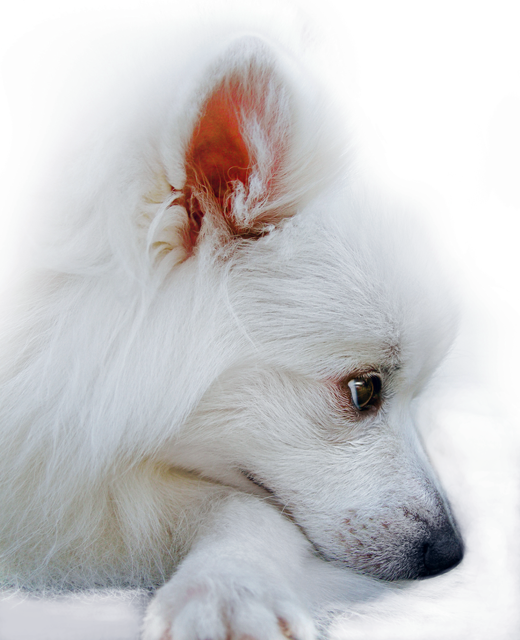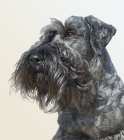Japanese Spitz

In my own words
I know right? The fluffy coat is just beautiful isn’t it? It is all mine, and it is completely non-stick and waterproof; just like your saucepan. That’s right! I am your typical Teflon dog! Now I have plenty of energy, so I don’t suppose you’re now about to take me out for a walk are you? My owner goes running a lot, and I really enjoy running with them. Fortunately she’s not that fast so I can easily keep up! Apparently no one is really sure where my breed started, so I guess that makes me really unique; and that’s that way I like it!
Don’t be put off by me being really small, I love the rough and tumble. Some people say I am like a big dog in a small dog clothes, and I guess that it’s right. Again I must ask, do you have anything for me to chase? It’s better me being small anyway, so that you guys who live in the cities can still have me as your pet! If you do become my owner, you can expect upmost loyalty from me. As long as you show respect to me back.
My ideal owner(s)
Retirees
Active singles
City dwellers
Families
What they say about me
Loyal
Intelligent
Big dog in small dog’s clothes
Energetic
Is this Japanese Spitz for you?
Test your knowledge about the Japanese Spitz
Information essential about the Japanese Spitz
Kennel Club Group:
Utility
Size:
Japanese Spitzen are very small dogs that are only on average between 12-15 inches (30-38 cm.). They weigh on average between 11-20 pounds (5-10 kg.)
Popularity:
Were very popular in the 1950s in Japan, but numbers have declined there ever since. Numbers increasing everywhere else around the world, especially in the USA and Europe.
Breed History:
It is not known exactly where the Japanese Spitz originated, but it is generally regarded that it descended from the native Siberian Samoyed. This claim is somewhat controversial, but the breeds closely resemble each other; especially when one considers that Samoyeds were bred in the 19th century to make them smaller. The dog also bares something of a resemblance to the to the American Eskimo Spitz type. Wherever they originated, the breed was recognised by the UK Kennel Club in 1981. Like most Japanese dog breeds, the onset of the Second World War threatened them, but the breed suddenly became popular in the 1950s (as a fluffy and cuddly dog) and thus this saed it from extinction.
Character:
The Japanese Spitz is, in spirit, a big dog in a little dog's body. This tough little dog acts as a house protector and guardian. The Japanese Spitz can be an inveterate barker if you allow them to believe they are in charge but be sure to tell the dog enough is enough and to quiet down if he starts barking obsessively. Japanese Spitz are typical of most small dog breeds. This means that they have plenty of energy, and will enjoy chasing things and being used as a jogging partner. They also enjoy plenty of ‘rough and tumble’ play time, but they are not aggressive. They are pretty, alert and high spirited; and very suited to the show ring. In fact this is the most major use for the dog. They can end up being very affectionate, and sometimes over protective of their masters. They also get on well with other animals as they are very aware and curious of what is going on around them. They are a very energetic little breed and this needs to be watched upon. If the dog does not get enough exercise it will try and expel its energy in other, more destructive, ways.
Temperament:
The breed can exhibit ‘small dog syndrome’. That is it will always look to become the dominate pack leader. A firm (but not aggressive) training system is essential, or the dog will not see you (it’s owner) as the dominant figure. When dogs are allowed to be pack leader to humans they can developed many types of behaviour issues, including, but not limited to, being suspicious of and barking at strangers, guarding, separation anxiety, destructiveness, snapping, and even biting. These are not Spitz traits, but rather behaviours resulting in a lack of leadership on the humans part. All of these traits are signs of a badly trained dog. They breed is great with older children, and certainly will not see them, or younger children as a threat. But, having said that, children need to exert the same dominance over the dog that adults do, so they are perhaps not best suited to families with very small children. The breed is very intelligent. It is eager to please and quick to learn, picking up new commands and following instructions with ease. Due to their size they can also make great apartment pets, as long as they do get enough exercise.
Conformation:
Japanese Spitz are very small dogs, but they do bare an undeniable resemblance to their larger cousins, the Samoyeds. They are a very fluffy and cute looking breed that is very suited to the parade ring. The nose should be round, small and black. The eyes should be dark, moderate in size, oval shaped and not too far apart with black eye rims. The ears should be small and angular, standing erect. They should be set high on the head facing forwards and not too wide apart. The jaws should be strong with a complete scissor bite. They should have a straight back with small, round and almost cat like feet. They have a curly, fluffy tail that should rest on their back.
Colour:
White
Training:
Japanese Spitz can exhibit something known as ‘small dog syndrome’. Essentially this means that it must be shown who is the dominant pack leader, at all times. Otherwise it will become the pack leader itself and so training must always be done consistently and firmly but never aggressively. They are an intelligent breed, and can learn tricks; such as catching Frisbees, which they really enjoy!
Care:
While the Japanese Spitz appears to have a very thick and unmanageable coat, this isn’t actually the case. They often clean themselves very thoroughly, especially after walks so bathing isn’t really necessary. But the coat also has a feature that means that it is non-stick, and waterproof; it is often compared with substance Teflon, which you will find is the non-stick coating on many pots and pans used in your kitchen. As a result the coat will need to be brushed and combed regularly. When the dog is shedding (and this occurs a lot when they are in season), use a comb with a double row of metal teeth to remove loose hairs from the under-layer. Due to being heavy shedders, they are not hypoallergenic and will affect those with fur allergies.
Health:
A healthy breed with few genetic problems, the main one being patellar luxation (slipping patella). This means the dog needs to be hip scored by a vet when it is a puppy. Other than that, they are not very susceptible to illness at all. Be careful e when checking the dog over (for lumps etc.) as it’s thick cat can get in the way and obscure some things. The dog can also experience problems with its eyes. Again it is best to consult a vet over this.
Exercise:
Japanese Sptiz are very energetic dogs and love to play with balls and chase sticks. It will need a moderate amount of exercise – up to 20 minutes daily. If you keep them in a garden this needs to be well fenced as they can get very curious and look to see what is behind it. They are very good dogs to live in an urban area, and they are really easy travellers due to their size. They have great potential to train for agility sports and are great running partners if you’re not too fast (they can’t keep up if you’re Usain Bolt or on a bicycle).
You may also like:
If you like Japanese Spitzs, you may be interested in breeds of the same size »





If you like Japanese Spitzs, you may like other breeds with similar characteristics »





If you like Japanese Spitzs, you may be interested in these other utility dogs »





Advice on choosing your breed »
Find an animal shelter or rescue home where a Japanese Spitz is waiting for a new home »
The following grid gives a fast track review which covers all breeds. You can apply it to help you decide if a Japanese Spitz suitable for you, the environment where you live, your personality and your lifestyle. On the grid, 1= strongly disagree, and 5= strongly agree. We can see here, for example that they are energetic dogs that seem to bark a lot; but that they also make good jogging companions. You might like to save or print off this section and keep it for reference while you check some other breeds before making your final choice.
Be the first to rate this breed »
|
*PLEASE NOTE: All our breed profiles are general, and all dogs are individuals. Always talk to the breeders and meet the owners you are buying from. Try to meet the dog and its parents if it is a puppy in their home environment.












